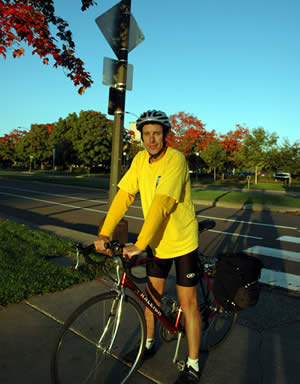By Lisa Yang

Mike Schadauer, director, Office of Transit, has been biking to work year-round since 1983 during his student worker days. Photo by Colleen Anfang |
The League of American Bicyclists ranked Minnesota as the fifth best bicycle friendly state for 2008, the first year of its rankings.
The league cited Minnesota’s policies requiring bike parking at state buildings, state funding for the installation of bike racks, exemplary bike-safety laws and statewide partnerships and efforts to protect and promote cyclists as reasons for the award.
The league ranked states in six categories: legislation, policies and programs, infrastructure, education and encouragement, evaluation and planning, and enforcement.
“We hope that everyone will use our ranking to raise awareness of bicycle safety and accommodation,” said Elizabeth Preston, League of American Bicyclists spokesperson.
Coming in as the number one bicycle friendly state was Washington. Rounding out the top four were Wisconsin, Arizona and Oregon.
Wheeling it to work
Mike Schadauer, director of the Office of Transit, has been biking to work year-round since he started as a student worker at Mn/DOT in 1983.
“I was taking the bus, but as a student, I didn’t want to spend my money on bus passes everyday,” said Schadauer. “So, I started biking instead.”
Schadauer currently lives in Minneapolis and bikes to Mn/DOT’s Central Office if conditions allow.
“I won’t bike when it’s very icy on the roads, or if it’s too cold,” said Schadauer. “I can’t take it if it’s lower than 10 degrees. I just ride the bus or drive myself.”
I build two
35-minute cardio workouts into my daily schedule. Compared to driving my vehicle, I only increase my total daily commute time by 15 minutes, but I gain a 70-minute workout.
David Larson
Office of Technical Support |
Schadauer, along with another Mn/DOT biker, David Larson, senior landscape architect, Technical Support, uses bicycle lockers that Mn/DOT has available for its employees.
Mn/DOT Central Office bicycle lockers are rented through the Department of Administration; currently, there is a waiting list for them.
“Having bike lockers and a locker room facility at CO is great,” said Larson, who has been riding to work for about 12 years now and feels that it’s a great way to exercise.
“I build two 35-minute cardio workouts into my daily schedule,” he said. “Compared to driving my vehicle, I only increase my total daily commute time by 15 minutes, but I gain a 70-minute workout.”
Schadauer noted that the Office of Transit is putting together a program to provide transportation alternatives to Minnesotans.
“Important issues and goals right now include incorporating safe bicycle and pedestrian space in roadways and bridges where appropriate, developing and publicizing a network of scenic bikeways in and across Minnesota, and encouraging safe use of roadways by motorists and bicyclists through the Share the Road program,” he said.
“We’re working to keep people thinking about bicycles as they design transportation facilities. We have also developed bicycle design guidelines and a bicycle modal plan.”
“More education and enforcement related to Share the Road would be a good thing,” agreed Larson. “I’d give Minnesota an eight for satisfaction.”
For more information about “Share the Road,” go to http://www.sharetheroadmn.org/.
For more information about bikeways, design, planning and funding, go to http://www.dot.state.mn.us/bike/.
|



